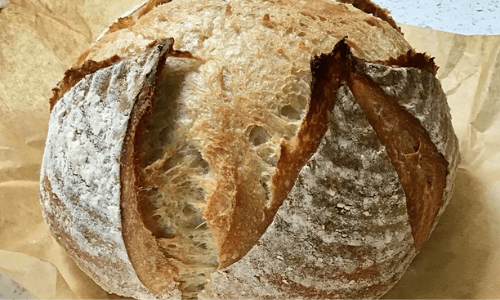How to Make a Sourdough Starter


Before you can make a sourdough loaf, you will need to pre-ferment a mixture of flour and water, also known as the sourdough starter.
The sourdough starter is a live culture, once combined, the starter will begin to ferment, cultivating the naturally occurring wild yeasts and bacteria present within the flour.
The starter becomes a yeast, which contributes to the sourdough flavour and also causes the dough to rise. Making your very own sourdough starter is very simple to do and will be ready to use in 7-10 days.
You will need:
- All-purpose flour or whole wheat flour
- Filtered water or pre-boiled water which has been cooled
- Kilner® Sourdough Starter Set
The Method
Day 1: Using the Kilner® measuring lid, measure out 60 grams of flour and 60 grams of water (please see diagram of measurements) and empty into the jar.
Using the spatula, stir well until smooth, make sure there are no clumps. Use the spatula to stir and clean the inside walls of the jar. Screw the metal lid on loosely, as you will need to allow some air to enter the jar. Leave to rest at room temperature of 20–22 °C (68–72 °F) for 24 hours.
Day 2: Stir the starter to incorporate air, screw the lid on loosely again and let it rest for another 24 hours at room temperature.
Day 3: Start the feed. Using a clean jar, measure out, 60 grams of starter you created in days 1 and 2, discard the rest of the mixture. The excess mixture can be used for pancakes and naan bread. In the same jar, using the Kilner® measuring lid, measure 60 grams of flour and 60 grams of water and combine with the starter.
Use the spatula to stir the mixture and clean the inside walls of the jar. Mark the level of the starter with the rubber band. Screw the metal lid on loosely, as you will need to allow some air to enter the jar. Leave to rest at room temperature of 20–22 °C (68–72 °F) for 24 hours.
Time and date your starter using the white labels to keep track. The sourdough starter will now start to activate and you will start to see bubbles appearing inside the jar.
Day 3-7: Feed twice a day. Repeat every day up to 7-10 days. The yeast should already be activating so the starter will rise when it starts to warm up and gets active.
The starter will leave a mark on the sides of the glass walls when it’s hungry. It is much easier to see if the starter has risen when you keep the glass jar walls as clean as possible, using the spatula. You won’t need to clean the jar each day, but ensure to keep the jar clean as possible.
During the feeding, discard 60 grams of your starter then scrape away as much of the residual as you can from the glass walls. Twice a day, weigh out 60 grams of the starter and discard the rest. In the same jar, using the measuring lid, measure 60 grams of flour and 60 grams of water and combine with the starter.
Use the spatula to stir the mixture and scrape the residue from the inside walls of the jar. Mark the level of the starter with the rubber band. Screw the metal lid on loosely, as you will need to allow some air to enter the jar. Leave to rest at room temperature of 20–22 °C (68–72 °F) for 24 hours.
By day 4, look for the hunger signs. This’ll be shown through the starter rising and falling. If the starter shows no signs of whether it has risen or fallen, then only feed once every 24 hours.
Feeding the starter when it isn’t hungry will dilute the growing yeast. By day 5 to 7, the starter should look visibly active, with bubbles, rising and close to doubling in size.
Day 7: The starter should hopefully be doubling in size within 4-6 hours of feeding. Let the starter rest at room temperature for 8 hours. At this stage, the starter should be active, with bubbles through and nearly reaching the top of the jar.
Float Test
Day 7-8: To test the starter, place a teaspoon from the top of the starter in a glass full of water. If it floats, you can now make Sourdough Bread! If the starter does not float, it’ll just require a few more days. Continue to feed once or twice a day, until you see the consistent, rise and fall, do the float test again.
If you need to take a break, keep the starter in the fridge up to 7 days and try it again.


